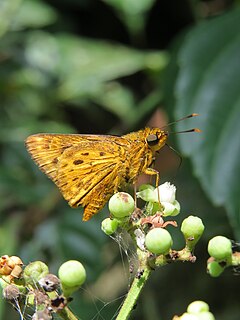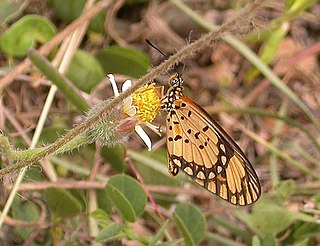
Libythea lepita, the common beak, is a butterfly that belongs to the Libytheinae group of the brush-footed butterflies family. It is found from southern India to Japan and its larval food plants include members of the Cannabaceae, particularly in the genera Celtis and Trema.

Libythea myrrha, the club beak, is a butterfly found in India that belongs to the Libytheinae group of the brush-footed butterflies family found in the Indomalayan realm.

Curetis bulis, the bright sunbeam, is a species of butterfly belonging to the lycaenid family. It is found in Asia.

Nymphalis xanthomelas, the scarce tortoiseshell, is a species of nymphalid butterfly found in eastern Europe and Asia. This butterfly is also referred as yellow-legged tortoiseshell or large tortoiseshell.

Thoressa honorei, commonly known as the Madras ace, is a skipper butterfly belonging to the family Hesperiidae found in south India.

Asota ficus is a moth in the family Erebidae first described by Johan Christian Fabricius in 1775. It is found in Afghanistan, Bangladesh, China, Taiwan, India, Indonesia (Sumatra), Laos, Myanmar, Nepal, Pakistan, Sri Lanka, Thailand and northern Vietnam.

Acraea serena, the dancing acraea, is a butterfly of the family Nymphalidae. It is found in South Africa, including the area near the Waterberg Biosphere. But it is found also in the whole Africa south of the Sahara. It is the most common of the Acraea, from Dakar to Fort-Dauphin, from Yemen to the Cape.

Acraea mirabilis, the marvelous acraea, is a butterfly in the family Nymphalidae. It is found in Somalia, south-eastern Ethiopia and north-eastern Kenya.

Euphaedra themis, the common Themis forester, is a butterfly in the family Nymphalidae. It is found in the Guinea, Sierra Leone, Liberia, Ivory Coast, Ghana, Togo, Benin, Nigeria and western Cameroon.
Euphaedra eleus, the Eleus orange forester, is a butterfly in the family Nymphalidae. It is found in Guinea, Sierra Leone, Liberia, Ivory Coast, Ghana, Nigeria, Cameroon, Gabon, the Republic of the Congo, Angola, the Democratic Republic of the Congo and Uganda. The habitat consists of primary forests and secondary forests with a closed canopy.
Euphaedra wissmanni is a butterfly in the family Nymphalidae. It is found in the southern part of the Democratic Republic of the Congo.
Syllepte tetrathyralis is a moth in the family Crambidae. It was described by George Hampson in 1912. It is found in New Guinea.
Arogalea crocipunctella is a moth of the family Gelechiidae. It is found in the West Indies, where it has been recorded from Saint Vincent.
Hypercallia heterochroma is a moth in the family Depressariidae. It was described by John Frederick Gates Clarke in 1971. It is found in Venezuela.
Hypercallia chionastra is a moth in the family Depressariidae. It was described by Edward Meyrick in 1926. It is found in Colombia.
Hypercallia niphocycla is a moth in the family Depressariidae. It was described by Edward Meyrick in 1926. It is found in Colombia.
Hypercallia loxochorda is a moth in the family Depressariidae. It was described by Edward Meyrick in 1926. It is found in Colombia.
Hypercallia alexandra is a moth in the family Depressariidae. It was described by Edward Meyrick in 1909. It is found in Peru.
Hypercallia gnorisma is a moth in the family Depressariidae. It was described by Lord Walsingham in 1912. It is found in Mexico, Guatemala and Panama.
Hypercallia phlebodes is a moth in the family Depressariidae. It was described by Lord Walsingham in 1912. It is found in Guatemala.








